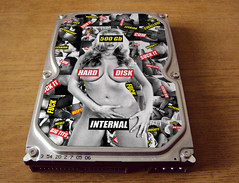Since Desktop Publishing (DTP) came out in the eighties, graphic designers have been utilizing computer technology. This has pushed all graphic designers to become competent with computer hardware at the very least.

What is Desktop Publishing (DTP)? In the 1980s, it was a common term applied to digital publishing systems. These systems were developed to replace large, pre-press, specialist design and compositing systems.
Hard Disk External
Graphic designers rely heavily on computers whether these are Windows PCs or Apple Macs. Whichever computer a graphic designer chooses to use, he/she will opt for the best computer that he/she can purchase. Graphic designers will rarely choose cheap computer hardware.
The Best Computer For Graphic Design
Back in the eighties, Macs were the only choice for designing and printing. Almost all design layout and graphics software was developed for Macs only or even if the software could be used in Microsoft Windows PC, it was much more reliable on a Mac. Additionally, at that time, Macs were associated with the different technologies used in the prepress and Windows PC was just not a practical choice. Today, modern versions of Mac OS X and Windows allow graphics designers to use design software either in a Mac or PC - they are no longer forced to choose one over the other.
Many graphic designers are not IT experts and making a decision on which computer to buy can be quite daunting. Of course, if money is not a problem, the decision would simply be to buy the most expensive Apple Mac or Windows PC. But most designers cannot afford to do that. In fact, some creative professionals have budgets for second hand equipment only. What really matters to these graphic designers are issues that regular computer users do not even have to think about. These are printer color accuracy, monitor calibration, hard disk speed and external storage devices for gigabytes of data.
Recent studies show that the top 5 computers for graphic design are a mix of Macs and PCs and both laptop and desktop computers fall in this category. But just like any product that a consumer buys, it really is the personal preference of the designer whether he/she will use a desktop computer or a laptop. The important thing is that the user/graphic designer has the appropriate software for the type of computer that he/she wants to purchase.
The Top 5 computers for graphic design are:
Mac Pro Desktop
The Mac line of computers is still widely preferred by most graphic designers. According to Apple, the latest Mac Pro features the all new quad-core Intel Xeon "Nehalen" processor which makes the job of a graphic designer much easier. Apple states further that the new Mac Pro is up to 1.9 times faster than its predecessor. Each processor has an integrated memory controller that allows the processors to have faster access to stored data in the computer's memory, with memory latency decreased by up to 40 percent. This feature will save a lot of time for designers when they do their work.
MacBook Pro Laptop
The MacBook Pro Laptop comes in 13, 15 and 17 inch sizes. It has high-performance NVDIA graphics and LED backlit display which makes editing graphics easier and clearer. This latest model has battery power that lasts up to 8 hours (on 17-inch version). It is powered by the Intel Core 2 Duo processor.
Dell Studio XPS Desktop
The Dell Studio XPS Desktop features the Intel Core i5 and i7 processors. If you plan on working with intensive video or 3D editing, you can have an upgrade to the 16GB Dual Channel DDR3 SDRAM. But its base 3GB memory will enable you to edit photos, create vector or raster designs with ease. Its high-definition ATI graphics card creates clear, precise and flawless graphics - just what a graphic designer needs.
Toshiba Qosmio Laptop
The Toshiba Qosimo is an affordable solution to your graphic design needs. It is powered by either the Intel Core i7 or i5 processor making it easier to create flawless graphics. It has a high-end NVIDIA GeForce graphics card, which ensures that you can clearly see every pixel and frame that you edit. It has a 6GB DDR3 1066MHz memory and a 1GB GDDR5 discrete graphics memory.
HP Pavilion Elite Desktop
The HP Pavilion Elite Desktop is an affordable computer. It is powered by either an AMD Athlon or an Intel Core processor that ranges from an X4 630 quad-core (Athlon) to an i7-980X six-core Extreme Edition (Intel). All HP Pavilion Elite Desktop computers come with genuine 64-bit Windows 7 for the latest technology. Memory ranges from 4GB up to 9GB which guarantees smooth and effortless run of the high-end graphics that you use.
Hard Disk External